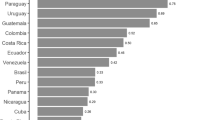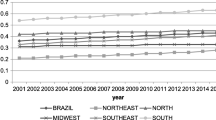Abstract
Purpose: To examine the pattern of testicular cancer incidence by age, time period and birth cohort since 1969 in Canada. Method: In addition to analyses of the secular trends by age group and birth cohort separately, an age-period-cohort model and the submodels with standard Poisson assumptions were fitted to the data. Results: The overall age-adjusted incidence of testicular cancer increased in Canada, from 2.8 per 100,000 males in 1969–71 to 4.2 in 1991–93. The younger age groups showed much higher absolute incidence rates in the recent period compared with those in the early period. Age-period-cohort modelling of data restricted to males aged 20–84 years suggested that the observed increase in testicular cancer could be largely attributed to a birth cohort effect. A steady increase in risk was observed among men born since 1945; those born between 1959 and 1968 were 2.0 (95% CI, 1.5–2.6) rimes as likely to develop testicular cancer as those born between 1904 and 1913. Conclusion: The risk of testicular cancer has increased over time and changing exposure to environmental factors early in life may be responsible for this.
Résumé
Objectif: examiner l’évolution de l’incidence du cancer des testicules par âge, période de temps et cohorte de naissance depuis 1969 au Canada. Méthode: outre les analyses des tendances générales par catégorie d’âge et cohorte de naissance séparément, on a appliqué aux données un modèle âge-période-cohorte et les sous-modèles avec les hypothèses habituelles de Poisson. Résultats: l’incidence générale, ajustée selon l’âge, du cancer des testicules a augmenté au Canada, passant de 2,8 pour 100 000 hommes en 1969–1971 à 4,2 en 1991–1993. Les catégories d’âge plus jeune sont apparues avoir des taux d’incidence absolus beaucoup plus élevés au cours de la période récente en comparaison avec la période antérieure. La modélisation âge-période de temps-cohorte des données limitée aux hommes âgés de 20 à 84 ans suggère que l’augmentation constatée du cancer des testicules pourrait être largement attribuable à un effet de cohorte de naissance. On a observé une augmentation régulière du risque chez les hommes nés après 1945; les individus nés entre 1959 et 1968 avaient 2,0 (95% IC, 1.5–2,6) plus de probabilité de développer un cancer des testicules que ceux nés entre 1904 et 1913. Conclusion: le risque de cancer des testicules a augmenté et les changements de l’exposition aux facteurs environnementaux au début de la vie pourraient en être la cause.
Similar content being viewed by others
References
National Cancer Institute of Canada (NCIC). Canadian Cancer Statistics 1997. Toronto: NCIC, 1997; 15–39.
Bergström R, Adami H-O, Möhner M, et al. Increase in testicular cancer incidence in six European countries: A birth cohort phenomenon. J Natl Cancer Inst 1996;88:727–33.
Zheng T, Holford TR, Ma Z, et al. Continuing increase in incidence of germ-cell testis cancer in young adults: Experience from Connecticut, USA, 1935–1992. Int J Cancer 1996;65:723–29.
Wanderås EH, Tretli S, Fosså SD. Trends in incidence of testicular cancer in Norway 1955–1992. Eur J Cancer 1995;31A:2044–48.
Møller H, Jørgenen N, Forman D. Trends in incidence of testicular cancer in boys and adolescent men. Int J Cancer 1995;61:761–64.
Brown LM, Pottern LM, Hoover RN, et al. Testicular cancer in the United States: Trends in incidence and mortality. Int J Epidemiol 1996;15:164–70.
Adami H-O, Bergström R, Möhner M, et al. Testicular cancer in nine Northern European countries. Int J Cancer 1994;59:33–38.
Band PR, Gaudette L, Hill GB, et al. The making of the Canadian cancer registry: Cancer incidence in Canada and its regions, 1969 to 1988. Ottawa: Canadian Council of Cancer Registries, 1993;16–21.
Le ND, Marrett LD, Robson DL, et al. Canadian Cancer Incidence Atlas, Vol. 1. Ottawa: Health Canada, 1995;20–24.
Horwich A, Malcolm DM, Hendry WF. Testicular tumours, In: Peckham M, Pinedo H, Veronesi U (Eds.), Oxford Textbook of Oncology Vol. 2, Oxford: Oxford University Press, 1995;1407–14.
Clayton D, Schifflers E. Models for temporal variation in cancer rates, I: Age-period and Age-cohort models. Stat Med 1987;6:449–67.
Clayton D, Schifflers E. Models for temporal variation in cancer rates, II: Age-period-cohort models. Stat Med 1987;6:469–81.
SAS Institute Inc., SAS Technical Report P-243, SAS/STAT Software: The GENMOD Procedure, Release 6.09, Cary, NC: SAS Institute Inc., 1993; 1–47.
Holford TR. Understanding the effects of age, period, and cohort on incidence and mortality rates. Annu Rev Public Health 1991;12:425–57.
Brown LM, Pottern LM, Hoover RN. Prenatal and perinatal risk factors for testicular cancer. Cancer Res 1986;46:4812–16.
Depue RH, Pike MC, Henderson BE. Estrogen exposure during gestation and risk of testicular cancer. J Natl Cancer Inst 1983;71:1151–55.
Gershman ST, Stolley PD. A case-control study of testicular cancer using Connecticut tumour registry data. Int J Epidemiol 1988;17:738–42.
Akre O, Ekbom A, Hsieh CC, et al. Testicular nonseminoma and seminoma in relation to perinatal characteristics. J Natl Cancer Inst 1996;88:883–89.
Author information
Authors and Affiliations
Corresponding author
Rights and permissions
About this article
Cite this article
Liu, S., Wen, S.W., Mao, Y. et al. Birth Cohort Effects Underlying the Increasing Testicular Cancer Incidence in Canada. Can J Public Health 90, 176–180 (1999). https://doi.org/10.1007/BF03404502
Received:
Accepted:
Published:
Issue Date:
DOI: https://doi.org/10.1007/BF03404502




